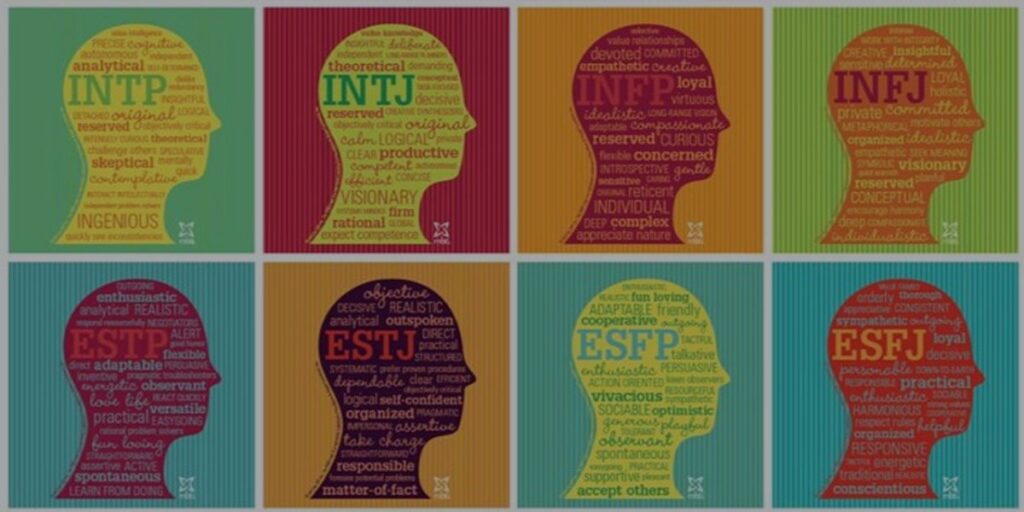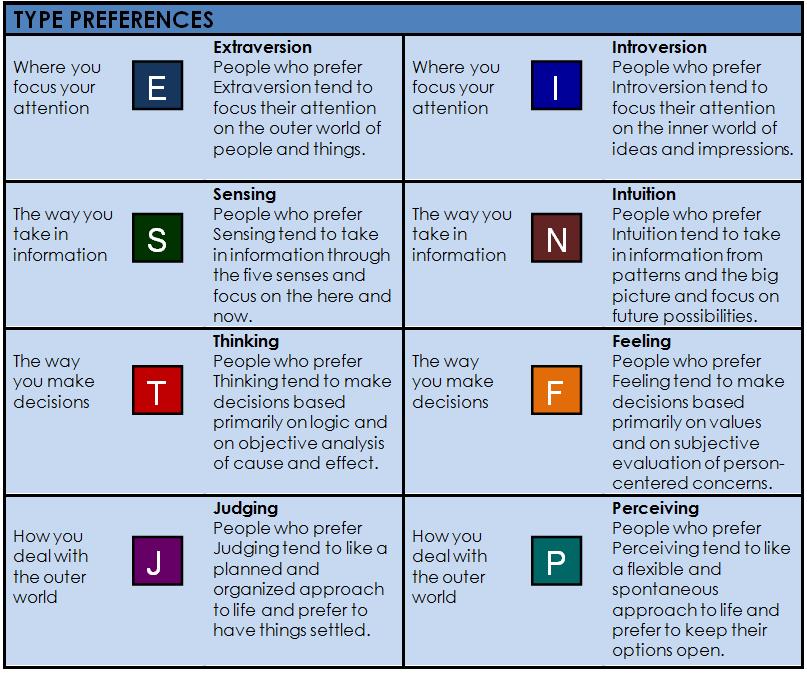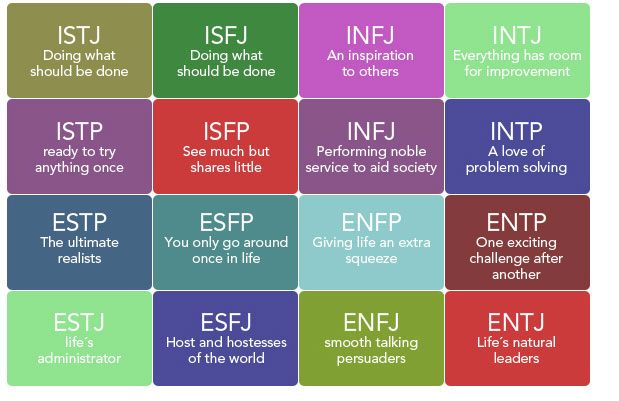In the previous article we saw the Personality – one of the first aspects of psychology.
As promised, we will show you now the MBTI tool that lets you find your own profile and that of others around you. This will help you at least to:
- Better manage yourself.
- Better manage your employees.
- Be in harmony with yourself and the people around you.

Myers Briggs Type Indicator (MBTI)
It is the most comprehensive tool, the clearest and most used today throughout the
professional world.
The main goal is to know the strengths and weaknesses of personality to better adapt to various situations of life.
It is also the most powerful instrument of personality to improve the leadership skills, improve communication and increase team effectiveness.
The MBTI personality inventory is based on the theory of personality type of Carl Gustav Jung.
Carl G. Jung was one of the great psychiatrists ever and the founder of analytical psychology.
Based on his theory, Katharine Cook Briggs and her daughter Isabel Briggs Myers developed the MBTI.
With over 70 years of studies, the MBTI is best studied in the world and the most widely used personality instrument.
More than 2 million people take the test each year and 70% of all Fortune 500 companies.
Myers-Briggs derived from the 16 personality types with natural strengths, weaknesses and blind spots.
Once we understand ourselves and how we are different from others specifically, we have a set of tools at hand to improve our personal and professional lives.
Types of MBTI
1. Growth and Development
2. Self-communication with others
3. Leadership and management skills
4. Appreciation of diversity and team effectiveness
The test Myers-Briggs Type Indicator (MBTI) was developed by Isabel Briggs Myers and her mother, Katherine Cook Briggs.
The MBTI is designed to indicate the psychological types of our personality as described by Carl Jung, Swiss psychiatrist, who tried to understand why there are individual differences between people.
The MBTI test helps people understand their preferences for the assimilation of information and decision making, as well as the way a person focuses favours their concentration and the way they prefer to live their existence.
More than 50 years after the MBTI was first created, it has become one of the assessment tools commonly used to understand the differences in personality.
The questionnaire is designed to enable a person to understand their behavioural profiles as defined by Jung, so they can make use of this knowledge in all areas of life.
Through this exploration, differences that can be the source of much error and
miscommunication are understood and more sensitively remedied.
The MBTI helps people to be grateful and tolerant towards other favoured styles of communication and behaviour patterns that are the result of different personality types from their own.
Because of this the MBTI is immensely valuable for understanding the interactions of the equipment and connections.
The MBTI can be applied to a wide range of reasons. Some of the most popular uses
include:
- The self-understanding
- Occupational Development
- Teaming
- Development of management and leadership
- Ratio improvement
According to the MBTI there are four pairs of opposite preferences, called dichotomies.
Where we direct our energy: Extroversion (E) – Introversion (I)
People who prefer Extroversion focus their attention on the outer world of things, people and events around them. They are often perceived as pleasant, verbally specialized and easy to learn. Derived energy to be with other people. Usually they do their thinking as they talk.
People with a preference for Introversion focus their energy and attention on the inner world of thoughts, ideas and perceptions. Usually they are perceived as reserved and harder to reach. They recharge their batteries being on their own. Usually they take time to gather their thoughts before speaking.
How do we take information: Sensing (S) – Intuition (N)
Detection refers to taking information especially with the five senses: hearing, sight, smell, taste and touch. People with a preference Perception pay attention to facts and details. They want to understand the parts first to understand the overall design. the sensors are often practical and realistic.
Intuition is “the big picture”, the meaning and connection behind the initial information. People with a preference for intuition enjoy concepts and theory and can be quite abstract. Usually they see the overall design first, then try to understand how individual parts contribute to the whole.
How we make decisions: Thinking (T) – Feeling (F)
Thinking people make their decisions based on objective impersonal logic, and are often good to analyze and solve problems rationally. They focus on tasks rather than relationships. They can seem cold or single people with a preference for sensation.
People with a sense base their decisions primarily on their value systems. They focus on the effect their decisions have on other people and their feelings, and they are good at understanding others. Their behaviour may appear too emotional and irrational to thinking types.
How do we organize ourselves and the world around us: Judging (J) – Perceiving (P)
People who prefer judge would have organized and orderly outside world. They tend to make plans and stick to them. They are decisive and like to have things in order. Sometimes they may seem rigid and inflexible to other types.
People with a preference for perception prefer to explore the world instead of organizing it. They are spontaneous and flexible. They prefer to gather information and leave things open. They can be perceived as disorganized and irresponsible people.
Once the candidate has completed the test, the results will explain MBTI preferences of an individual’s personality through four representative dimensional scales (capital letters indicate the reference acronym used).
Scale 1 – The centre of attention.
Extraversion (E) – Prefers to draw energy from the outer world of activity, people and things, or Introversion (I) – Prefers to draw energy from the inner world of thoughts, feelings and ideas
Scale 2 – The way you take in information.
Detection of (S) – prefers to focus on the information obtained from the five senses and on practical applications, or Intuition (N) – prefers to focus on patterns, connections and possible meanings.
Scale 3 – How the decision is made.
Thinking (T) – Prefers to base decisions on logic and objective analysis of cause and
effect, or Feeling (F) – prefer to base decisions on a valuing process, considering what is important to people.
Scale 4 – The way to deal with the outside world.
Judging (J) – likes a planned approach, organized life, and prefers to have things
in order, or Perception (P) – like a flexible approach, spontaneous and prefers to keep options open.
There are no right or wrong answers to complete the MBTI. In fact, a major part of the MBTI is that it focuses on the strengths and relevant qualities of different styles of personality and as a result of the feedback provided is always constructive.
MBTI questionnaire results are only for personal use of each participant. When these results should be shared among team members for an event team-building arrangement of the outputs it must be agreed with each part.
The completion time of the MBTI test is typically 15 – 25 minutes. The questionnaire asks 80 questions, with a choice of two behavioural states, where people choose the statement that best aligns with the way they usually feel or act.
Discover your MBTI profile
As we already saw, the analysis is based on four dimensions:
- Orientation of energy: E Extraversion / Introversion I
- Collecting of information: Sensation S / N Intuition
- Decision Making: Thought T / F Feeling
- Action mode: Judgment J / P Perception
The MBTI indicator then identifies 16 major personality types from the 2 possible preferences on each of the previous 4 dimensions. Knowing your 4 preferences shows your MBTI type. They are 16 in number.
The 8 preferences of MBTI

The 16 types of MBTI

Find the Dominant and Inferior
We begin by looking at the external 2 letters.
The following rule applies.
For Outgoing personality
If the last letter is [J], then the dominant will be the 3rd letter.
And if the last letter is [P], then the dominant will be the 2nd letter.
For Introverted personality
If the last letter is [J], then the dominant will be the 2nd letter.
And if the last letter is [P], then the dominant will be the 3rd letter.
The inferior is the opposite of the dominant.
Example:
ENTP – dominant = N and inferior = S
ISTJ – dominant = S and inferior = N


